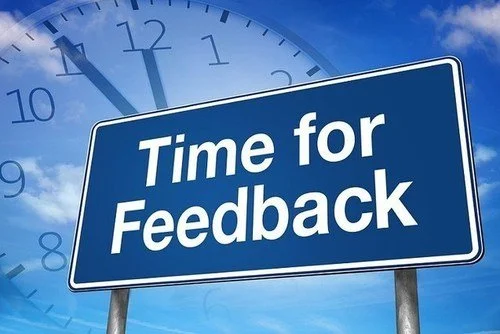CREATING A CONSCIOUS FEEDBACK CULTURE
GOOD FEEDBACK IS RARE
There’s a ton written about feedback. There is a wealth of research on the benefits of feedback to individuals, teams and organizations. There is actually a list online of the one hundred best books on feedback. And yet, despite all this, you’ve probably noticed that you rarely get really useful feedback—the kind that helps you grow as a person and a conscious leader.
This was my experience in the multiple organizations I worked in. And I’ve seen this problem in every organization I’ve consulted with. Most organizations don’t have a strong feedback culture. Usually managers give feedback on an individual project and otherwise leave feedback for the biannual review.
But even those organizations that do have an intentional feedback processes struggle to generate truly helpful feedback. When I was a management consultant at McKinsey & Company, we took pride in having a feedback culture. We received training during orientation on how to give useful feedback, and every team member was expected to have regular feedback sessions every two weeks—at least with one’s manager and sometimes with one’s manager’s manager. Sounds ideal, right?
Well it wasn’t. I rarely received feedback that I perceived as helpful and I doubt that I gave particularly good feedback either. And I would hear from my friends at McKinsey that they were having the same experience.
It wasn’t until I started working in leadership development with colleagues who were focused on relational skills that I came to understand the potential that feedback has to help us up-level of ability to show up as conscious, evolving leaders. With these colleagues, I started to get really powerful feedback that began shaping and accelerating my growth as a leader and a person. And I started to give feedback that people said was really changing their way of showing up for the better too.
So here’s a primer on the basics of a creating a feedback culture as well as the next level practices that that create a powerfully conscious and growth-oriented feedback culture.
FEEDBACK BASICS
IDENTIFY AND TRACK GOALS
Integrate SMART goals into your feedback sessions such that they move you toward your long-term development objectives. Use a time frame that makes sense for your organizations (e.g. quarters). This way the feedback is directed toward a vision—not just tactical adjustments that have no larger meaning.
BE CONSISTENT
Often I tell my clients to go out and solicit feedback and they come back and say, “They reports didn’t have much to say.” If that happens to you, keep requesting feedback. There’s something about consistency that normalizes and creates space for feedback to show up. Depending on how closely you work together (i.e. how many observations you actually have of one another’s work), I suggest you have feedback on your calendar every 2-4 weeks.
START WITH STRENGTHS
Often times people associate feedback with grade school when the teacher marks up your paper in red. Not surprisingly, a lot of people have a negative reaction to getting feedback. Focusing on strengths as part of feedback is actually more effective than just focusing on negative material. I recommend starting each feedback session by identifying successes and strengths we’ve witnessed in the other person before moving on to constructive feedback.
FOCUS ON BEHAVIORS, NOT TRAITS
To make feedback actionable, use observed behaviors rather than judgmental traits. For example, “Your oral communication skills are lacking” is not as useful as “At this morning’s meeting, you used 54 ums.” The latter is more specific and allows for more focused action.
SHARE IMPACT INSTEAD OF JUDGMENT
“At this morning’s meeting, you used 54 ums. I felt distracted and it was hard to focus on your message” is more useful than “At this morning’s meeting, you used 54 ums. It’s really holding you back and you need to improve.” Sharing subjective impact on yourself is less likely to create defensiveness than sharing a judgment.
LISTEN, DON’T DEFEND
Feedback becomes useless if it just becomes justifying why you did what you did. If the other person, shares some impact they experienced based on your behavior, empathize by repeating back what they said to make sure you understood it. It’s fine to share your experience and motivations but don’t make the other person’s experience wrong–let both exist and move forward from there.
COMMIT TO ACTION AND BE ACCOUNTABLE
If you’re serious about growth and meeting goals, then make specific commitments between your feedback sessions and then check in on them. For example, “Before each meeting this week, I’m going to make a conscious effort to use silence instead of saying uhm when I’m speaking. Will you check in with me next session to see how that goes?”
USE ON-THE-COURT FEEDBACK
Share feedback right after an event. 30 seconds of feedback can be helpful. “I noticed you used silence a lot in your speech instead of uhms today. I felt excited seeing your growth and noticing how much easier it was for me to focus on your message. Keep it up.” These on-the-court micro-feedback moments are exceptionally helpful in building up habits.
So these are the basics—the things you might learn in one of those 100 best books on feedback. Next level conscious feedback requires a courageous willingness to address the dynamics underneath the feedback.
NEXT LEVEL CONSCIOUS FEEDBACK
MAKE SURE THEY’RE ENROLLED
The person receiving feedback needs to want to get feedback. If there’s a feedback system imposed on them, the message is. “This is the way it is and, if it sucks for you, too bad.” Well guess what? These captives are very unlikely to have a mindset that’s going to get anything useful out of these conversations. Your job as the person proposing a feedback relationship is to enroll them in the possibility of growth through feedback.
MAKE SURE THERE’S TRUST
If you don’t think the other person has your back, why would you say anything risky to them? It’s crazy how foundational this is and how little it’s addressed in the thousands of articles about feedback. The reason is because trust is a huge issue in the workplace. And we’re in a transitional time where domination hierarchies are giving way to “power with” orientations in which more trust is possible. I’ll be writing more in-depth on this topic in the future. But a simple rule of thumb is be real and communicate openly and authentically. If you notice there’s a lot you’re thinking and not saying, the other person will often sense that and reciprocate creating a cycle of distance and mistrust.
CREATE 2-WAY FEEDBACK
Traditionally feedback only flows down. This is from an increasingly antiquated view of work that is based in domination hierarchy. It might be useful for the manager to feel in control and safe at the expense of the report, but it’s not that useful for either of you to be growing and developing. Most employees have been conditioned to view work from this mindset and so it is initially confusing when the manager asks the direct report for feedback. A couple tips:
Share what your growth goals are as a manager and some examples of what useful feedback might look like
Request that both of you come prepared with feedback to each feedback session
Ask questions that address the direct report’s needs. For example, “What are some ways I could improve how I work with you?” or “What are some ways I could accelerate your growth and effectiveness?”
ADDRESS THE POWER DYNAMIC
Often times our roles can get in the way of getting good feedback. I once spoke with a CEO who told me that his team has great communication but the problem is that they come to him with too much feedback as a result. I then heard about his employees complaining that they couldn’t bring up their biggest concerns with him because he wouldn’t take it well. These kinds of behavior is deeply ingrained—not to mention structurally incentivized by job and financial security. Thus, it takes a concerted effort from a manager to acknowledge the power dynamic and make it safe for the direct report to share openly. A couple recommendations:
Acknowledge that there is a power dynamic and that it can be uncomfortable for some people to give upward feedback
Share why you as a manager want feedback
Assure the report that you want and have received challenging feedback before and that you won’t be holding it against them if they give you feedback
Share examples about how past feedback was hard to hear but ultimately helped improve your working relationships
When you get constructive feedback, don’t offer any rationalizations or explanations. Instead, just try to understand the other person’s perspective
SHIFT THE POWER DYNAMIC
This gets into much larger decisions about organizational design and performance review. There are a variety of next level “power with” structures possible to ensure more authentic communication but one simple and not-so-radical reform is to ensure one’s manager is not solely responsible for reviewing the report’s performance. At McKinsey we had a senior person who we did not work with that served as the point person for our reviews. They would reach out to everyone we worked with to collect a robust picture of our performance. De-coupling the manager’s role as sole evaluator from their role as a manager-coach can drastically lessen the barrier to authenticity.
If this sounds hard, that’s because it is. Creating a culture of conscious feedback is not a turnkey event—it’s a relationship that requires the on-going work of authentic communication. So where do you start?
STEP ONE: DESIGN THE FEEDBACK PROCESS
Here’s a sample agenda:
Share why you’re bringing this up (i.e. why does it matter to you and what’s your motivation?)
Share your vision of feedback and describe it in a way that you imagine will make it sound desirable from the other person’s perspective
Ask them whether they’re interested and clarify that no is a fine answer
Design the agreements that make explicit how the feedback process is going to work (e.g. be for each other’s growth, be real, focus on strengths and development opportunities)
Propose a process (e.g. we’re going to meet every X number of weeks for Y amount of time and we’ll take turns looking at our goals, reviewing our commitments, then soliciting strengths and constructive feedback)
If you’d like to learn more about how to up level feedback for yourself or your organization, drop me a line and let’s discuss!
———————————–———————————–———————————–———————————–———————————–
Kan Yan is the founder of Sapient Leadership. Sapient is Latin for wisdom and it is what makes humans special. Homo sapiens means wise human. Sapient Leadership helps purpose-driven leaders realize their visions for a better world through fierce wisdom and effectiveness.



